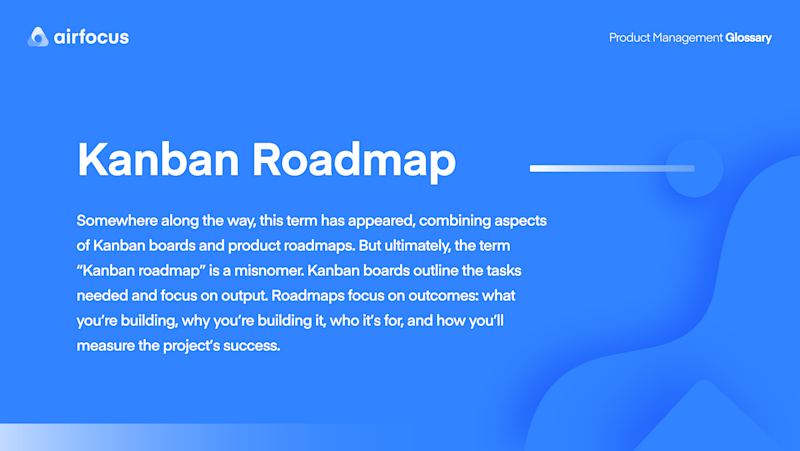Kanban Roadmap
What is a Kanban Roadmap?
Definition of a Kanban Roadmap
There’s been a recent rise in the use of the term “Kanban Roadmap.” And if you’ve found this glossary, you’re probably curious to learn just what a Kanban roadmap is. Well, we’ve got a secret for you: there’s no such thing as a Kanban roadmap. Somewhere along the way, this term has appeared, combining aspects of Kanban boards and product roadmaps. But ultimately, the term “Kanban roadmap” is a misnomer.
Let’s break it down into its individual components.
The origins of Kanban
The Kanban board is a very popular project management tool that helps visualize work and maximize efficiency. Car manufacturer Toyota first developed the Kanban methodology in the 1940s.
Industrial engineer Taiichi Ohno developed Kanban to improve manufacturing efficiency in Toyota’s factories. Ohno identified how Toyota’s manufacturing process produced waste, including materials, labor, time, inventory, and more. He then decided to cut down waste in these areas by only making what was needed when they needed it.
Ohno then further refined this system by adding paper cards to the mix. These cards were called “Kanban,” which translates from the Japanese characters “kan” 看, which means sign, and “ban”板, which means board. The cards were attached to each finished product. Once a product sold, the card would return to the production line. Team members could only begin production on a new item when they received the corresponding card.
This system became known as Just-In-Time (JIT) manufacturing and ensured optimal production by anticipating demand and allocating resources accordingly.
What is a Kanban board?
As for the origin of Kanban boards in digital product development, a Microsoft software developer named David J. Anderson first recognized the value of these lean systems for the digital world. From there, he developed the modern Kanban board as we know it today.
A digital Kanban board is a project management tool that splits tasks into different workflow categories. These categories represent different stages of a team’s progress and current capacity for work.
You can read more about Kanban boards and how to use them here.
What is a product roadmap?
Product roadmaps are high-level visual tools that summarize the intention and direction of your product. Roadmaps communicate the strategy — what, why, and for whom — behind what you’re building. They express a product’s strategic direction, and your product roadmap will change as you uncover more information around your objectives, company direction, and market demands.
Proper roadmapping is what we built airfocus to do, so it’s a topic close to our hearts. You can find multiple roadmap resources on our blog and here in our product management glossary guide.
Why are people talking about “Kanban roadmaps”?
We’ve already discussed that Kanban roadmaps don’t actually exist. So why is everyone talking about them then?
It’s fair to say that even though you can’t combine Kanban boards and product roadmaps, there are certain overlaps between the two.
Ultimately, Kanban boards and roadmaps aren’t compatible because they work differently and focus on different goals. Kanban boards move from left to right. Each card has to move through each column or category in order and can’t skip any steps along the way. Kanban boards essentially outline the tasks your team needs to accomplish and focus on output.
Roadmaps move in the opposite direction, from right to left. And unlike Kanban boards, roadmaps lack a rigid workflow. Your roadmap is a living, breathing document and will flex and change based on internal and external conditions. Items can move from anywhere on the roadmap to any column.
There’s no particular flow of progress because roadmaps lay out what your team wants to explore and build, not how they’ll do it. Roadmaps focus on outcomes: what you’re building, why you’re building it, who it’s for, and how you’ll measure the project’s success.
Can you use Kanban boards and product roadmaps together?
Even though “Kanban roadmaps” aren’t a thing, that doesn’t mean Kanban boards and product roadmaps can’t be used side-by-side. One way to use the two tools together is to use each as a zoomed-in and zoomed-out view of your project.
Zoom in on your project, and you’ll find a Kanban board. Zoom out, and you’ll see a roadmap.

General FAQ

Glossary categories
Experience the new way of doing product management

Experience the new way of doing product management








